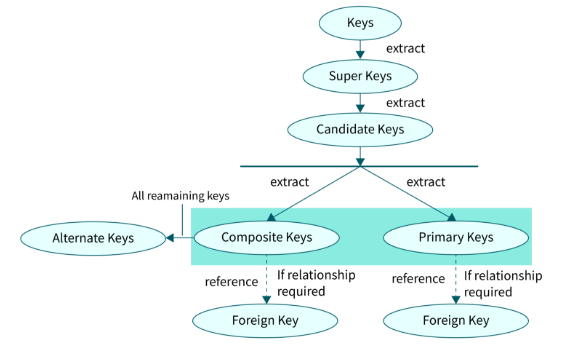
- What is a Primary Key in SQL?
- Why Do We Need Primary Key in SQL?
- The syntax for Defining a Primary Key in SQL
- Properties of Primary Key in SQL
- Benefits of Using a Primary Key
- Example: Primary Key in Action
- Best Practices in SQL
- Conclusion
A Primary Key in SQL is one of the most fundamental concepts in relational databases. It uniquely identifies each record in a database table and plays a critical role in maintaining data integrity. Using a primary key, SQL Training ensures that every record within a table is distinct and can be reliably referenced by other tables or queries. A primary key cannot contain NULL values, ensuring that every row has a unique and valid identifier. Primary keys are often used to create relationships between tables through foreign keys, enabling normalization and reducing data redundancy.
What is a Primary Key in SQL?
A Primary Key is a column or a set of columns in a table that uniquely identifies each row in that table. It ensures that no two rows have the same value for the primary key column(s). Additionally, a primary key column cannot contain NULL values, and only one primary key can exist in a table. A primary key helps to create relationships between tables in a database, as it is often referenced by foreign keys in other tables. Primary keys are essential for maintaining data integrity and preventing duplicate entries. Database Administration also improve query performance by allowing faster searches through indexing. In complex systems, a composite key (a key made of multiple columns) may be used when no single column uniquely identifies a row. Overall, primary keys form the foundation of relational database design, enabling structured and reliable data organization.
Learn how to manage and deploy SQL services by joining this SQL Training today.
Why Do We Need a Primary Key in SQL?
A Primary Key in SQL is essential for maintaining the integrity and structure of a relational database. It plays a crucial role in ensuring that each record in a table is unique and identifiable. In a relational database, tables are designed to hold large amounts of structured data, and without a primary key, the database would lack a way to identify each row distinctly. Let’s explore why primary keys are so important: They prevent duplicate records, which ensures that each entry in the table is meaningful and consistent. Primary keys also help in linking tables through foreign keys, supporting relational integrity across the database. Mongodb enable efficient indexing, which boosts query performance during searches, joins, and lookups. By enforcing the NOT NULL constraint, primary keys ensure that every record has a valid and complete identifier. Overall, primary keys serve as the backbone of data relationships and provide a foundation for clean, reliable database design.

- Ensuring the Uniqueness of Records: One primary reason for using a primary key is to ensure the uniqueness of records in a table. Primary key guarantees that no two rows in a table have identical values in the columns designated as the primary key. This is vital in preventing data duplication, which can lead to errors in reporting, analysis, and data integrity. For example, consider a table of employees with a unique employee_id identifying each employee. Without a primary key, two employees might end up with the same employee_id, which can be confusing when querying data. The primary key ensures that every employee record is unique.
- Establishing Relationships Between Tables: A primary key is essential for creating relationships between tables in a relational database. In a well-designed relational database, data is usually split across multiple tables, which are linked together using keys. The primary key in one table can be referenced as a foreign key in another table. Database Management and Benefits of DBMS relationship helps to maintain referential integrity, ensuring that data is consistent across the database. For instance: A customer table may have a primary key customer_id. An orders table might reference this customer_id as a foreign key to associate each order with the correct customer. Without a primary key in the customer table, this relationship would be impossible to establish, and the database structure would lack integrity.
- Data Integrity and Consistency: Primary keys ensure data integrity by enforcing rules that prevent specific data errors. For instance: A primary key cannot contain NULL values, meaning every row in the table must have a unique and non-null identifier. The uniqueness of a primary key guarantees that each row can be reliably identified and retrieved, minimizing the risk of errors in data retrieval or manipulation. This is particularly important when performing CRUD (Create, Read, Update, Delete) operations, as having a reliable identifier (primary key) ensures the consistency of the data.
- Creating a Primary Key during Table Creation: When creating a new table, you can define a primary key directly in the CREATE TABLE statement.
- CREATE TABLE employees (
- employee_id INT PRIMARY KEY,
- first_name VARCHAR(50),
- last_name VARCHAR(50),
- email VARCHAR(100)
- );
- employee_id is the primary key.
- It ensures that every employee in the table has a unique employee_id.
- Defining a Composite Primary Key (Multiple Columns): Sometimes, a combination of columns is required to identify a record uniquely. This is called a composite primary key.
- CREATE TABLE orders (
- order_id INT,
- product_id INT,
- quantity INT,
- PRIMARY KEY (order_id, product_id)
- );
- Adding a Primary Key to an Existing Table: If you have an existing table and want to add a primary key, you can use the ALTER TABLE statement:
- ALTER TABLE employees
- ADD CONSTRAINT pk_employee_id PRIMARY KEY (employee_id);
- pk_employee_id is the name of the primary key constraint.
- employee_id is set as the primary key.
- Ensures Data Uniqueness: The primary key guarantees that every row in the table is unique. This is essential for avoiding duplicate data and ensuring that each record can be distinctly identified.
- Improved Query Performance: Because SQL creates an index on the primary key, lookups, and queries based on the primary key are highly efficient. The index allows the database to quickly find rows without scanning the table.
- Establishing Relationships: Primary keys are critical for establishing relationships between tables in a relational database. Mongodb vs Dynamodb in other tables refer to the primary key, creating one-to-many or many-to-one relationships between tables. This helps create normalized and structured databases.
- Data Integrity: Enforcing non-null values in the primary key column ensures data integrity, as each record must be unique and cannot be left incomplete.
- Simplifies Data Management: With primary keys, you can easily update or delete rows without affecting other records. This is important in maintaining consistent data, especially when dealing with large datasets or performing CRUD (Create, Read, Update, Delete) operations.
- Prevents Redundant Data: Primary keys prevent redundancy by enforcing uniqueness, ensuring that no two records have the same identifying attributes. This contributes to cleaner, more efficient data management.
- CREATE TABLE customers (
- customer_id INT PRIMARY KEY,
- name VARCHAR(100),
- email VARCHAR(100)
- );
- CREATE TABLE orders (
- order_id INT PRIMARY KEY,
- customer_id INT,
- order_date DATE,
- total_amount DECIMAL(10, 2),
- FOREIGN KEY (customer_id) REFERENCES customers(customer_id)
- );
- customer_id is the primary key in the customer’s table, ensuring that each customer is uniquely identified.
- order_id is the primary key in the orders table.
- The customer_id column in the orders table is a foreign key that references the customer_id in the customer’s table, establishing a relationship between customers and their orders.
Dive into SQL by enrolling in this SQL Training today.
The syntax for Defining a Primary Key in SQL
When defining a primary key in SQL Training, you have two main ways to implement it: during table creation or by altering an existing table.
In this example:
In this example: Combining order_id and product_id forms the composite primary key, ensuring that this pair uniquely identifies each product in an order.
In this example:
Properties of Primary Key in SQL
In SQL, a Primary Key has several important properties that ensure the integrity and efficiency of relational databases. One key property is uniqueness, meaning each record in a table must have a unique value for the primary key column(s); no two rows can share the same value. Another essential property is non-nullability, which ensures that primary key columns cannot contain NULL values; every record must have a valid identifier. A table can only have one primary key, but Mongodb vs MySQL can be a composite key made up of multiple columns. Additionally, SQL automatically creates a unique index on the primary key column(s) to enhance performance when querying data. Primary keys also enforce referential integrity by linking to foreign keys in other tables, helping maintain consistency across related records. Moreover, primary keys are vital for ensuring accurate joins between tables, especially in complex queries. They play a critical role in normalizing data, reducing redundancy, and improving overall database structure. Well-designed primary keys can significantly boost query performance and help prevent data anomalies. Ultimately, the primary key serves as the backbone of relational database design, anchoring the relationships and logic that keep data structured and reliable.

Benefits of Using a Primary Key
Ready to excel in SQL? Enroll in ACTE’s Master Program and begin your journey today!
Example: Primary Key in Action
Consider a scenario where we have two tables in a database: customers and orders. Customers table:
orders table:
In this example:
The primary key in the customer’s table ensures that each customer is uniquely identified. The foreign key in the orders table guarantees that each order is linked to an existing customer, preserving referential integrity.
Best Practices in SQL
In SQL, one of the most important best practices is to always define a primary key for each table. A primary key ensures that each record is uniquely identifiable, which is critical for maintaining data integrity and enabling efficient queries. It is recommended to use simple, stable, and preferably numeric keys, such as auto-incrementing integers, instead of natural keys like email addresses or names, which can change over time. Avoiding composite or overly complex keys helps keep the database schema clean and performance optimized. Additionally, enforcing NOT NULL and UNIQUE constraints, using consistent naming conventions, and indexing foreign keys that reference primary keys are essential practices. Database steps not only improve query performance but also maintain strong relational links between tables. Furthermore, following database normalization rules and planning for scalability—such as choosing appropriate data types like BIGINT for growing datasets ensures long-term efficiency. Altogether, these best practices contribute to a reliable, scalable, and well-structured SQL database design.
Preparing for SQL interviews? Visit our blog for the best SQL Interview Questions and Answers!
Conclusion
The primary key is a cornerstone of relational database design in SQL. It serves as the unique identifier for records within a table and is essential for maintaining data integrity, consistency, and performance. By enforcing uniqueness and SQL Training , primary keys ensure that each record in a table can be precisely identified, which is crucial for establishing relationships between tables and providing accurate data management. By understanding primary keys’ syntax, properties, and benefits, database administrators and developers can build efficient and reliable relational databases that scale as needed.



